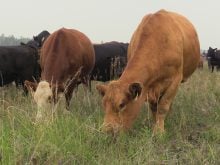This cattle market information is selected from the weekly report from Canfax, a division of the Canadian Cattlemen’s Association. More market information, analysis and statistics are available by becoming a Canfax subscriber by calling 403-275-5110 or at www.canfax.ca.
Fed prices lower
The fed steer average price in light trade during the July 1 holiday-shortened week was $191.92 per hundredweight live, down $1.72, and heifers were $189.80.
Business was exclusively on a rail basis with sales ranging from $320-$322.50 per cwt. delivered.
Packer margins are very low, and feedlots are current in their marketing.
Read Also

U.S. market can’t easily be replaced
The deputy chief economist of Farm Credit Canada says 92 per cent of Canada’s total exports to the U.S. went into the country duty-free in June.
The cash-to-futures basis weakened sharply to +$1.77 but remains strong for this time of year.
Weekly western Canadian fed slaughter to June 27 was steady at 32,066 head.
Weekly fed exports to June 20 more than doubled to 3,535 head.
Fed cattle prices have fallen from record highs to a more sustainable level. The trade will be watching to see how beef sold over the July holidays in Canada and the United States.
Live cattle trade in the U.S. south was at US$150, up $2 from the previous week.
Dressed sales in the north were steady to $3 higher ranging from $238-$242.
More cows sold
Auctions are seeing more cows and bulls because of dried up pasture, but packers are not increasing the slaughter rate.
D1, D2 cows ranged C$130-$147 to average $138, up $1.30. D3 cows ranged $117-$135 to average $125.38.
Rail grade cows were $262 to $267.
Slaughter bulls were $168.88, up $1.75 per cwt.
Slaughter should increase near term as it has from June to July over the past three years.
Cost of gain rises
Feed costs are rising, with corn up 70 cents over the past couple of weeks and southern Alberta new crop barley bids reported at more than $5 per bushel delivered.
That will limit feeder price increases, barring a rally in fed cattle futures.
Trade was light and prices were lower in Alberta and Saskatchewan on limited supplies and varying quality.
Only 8,500 head traded in Alberta and Saskatchewan. Buyers are likely having a tough time assembling load lot groups.
Most of the feeders at auction are heifers.
Volumes were too light to establish a price trend in British Columbia and Manitoba. Many commercial auctions have switched to summer schedules with bi-weekly or monthly sales.
Feeder export volumes to the U.S. have seasonally tapered off.
The forward delivery market saw 825-925 pound heifers for September delivery trading from $233.75-$242.75 per cwt.
Feeder volumes might pick up over the next couple of weeks if dry weather continues.
Bred cows ranged $1,700-$2,375.
US beef down
U.S. boxed beef prices fell last week with Choice at US$250.12 down $5.04 and Select $248.05, down $2.08.
Retailers had their needs met for July 4, and beef demand tends to drop in the hot days of summer.
Ample pork and poultry supplies may place additional pressure on beef prices.
Canadian boxed beef prices for the week ending June 26 were unavailable.
The Montreal wholesale price for delivery this week was steady at $342-$344 per cwt.














